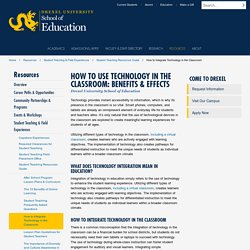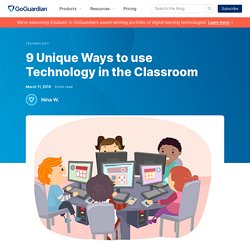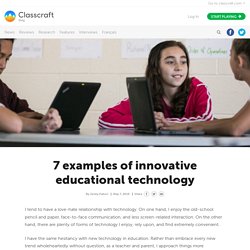

How to Integrate Technology in the Classroom. Technology provides instant accessibility to information, which is why its presence in the classroom is so vital.

Smart phones, computers, and tablets are already an omnipresent element of everyday life for students and teachers alike. It’s only natural that the use of technological devices in the classroom are explored to create meaningful learning experiences for students of all ages. Utilizing different types of technology in the classroom, including a virtual classroom, creates learners who are actively engaged with learning objectives.
The implementation of technology also creates pathways for differentiated instruction to meet the unique needs of students as individual learners within a broader classroom climate. 9 Unique Ways to use Technology in the Classroom. Finding creative ways to use technology in the classroom can both make your life easier as a teacher and boost student excitement levels and engagement with lessons.

From helping with communication among teachers and students (as well as peer-to-peer), to organizing curriculum calendars, to enhancing presentations and lessons with media and visuals, there is no limit to the ways to use technology in the classroom to create an enriched learning environment. If you’re looking for ideas of exactly how to use technology in the classroom to enhance learning, some examples include: Gamified learningDigital field tripsIntegrate social mediaGather student feedbackCreating digital contentUsing a shared, online classroom calendarReview and critique webpagesIncorporate video and multimedia into lessons and presentationsOnline activities for students who finish work early 1.
Technology in the Classroom in 2019: 6 Pros & Cons. Technology in education is the biggest change in teaching we will ever see. For years, policy makers, teachers, parents and students alike have been weighing the potential benefits of technology in education against its risks and consequences. But now the debate is more pressing than ever, as curricula increasingly incorporate technology and professors experiment with new teaching methods. On one hand, technology allows you to experiment in pedagogy, democratize the classroom and better engage students. On the other hand, some argue technology in the classroom can be distracting and even foster cheating. School Website Design & Mobile Apps Blog by Webanywhere. How to Get the Most Out of Educational Technology.
What innovations are big in the EdTech market?

What tools are your peers are using at other schools? What companies are pushing the envelope to create new ways of learning? We answer these questions and more below. Education Technology Solutions - Australia's leading EdTech Resources. 7 examples of innovative educational technology. I tend to have a love-hate relationship with technology.

On one hand, I enjoy the old-school pencil and paper, face-to-face communication, and less screen-related interaction. On the other hand, there are plenty of forms of technology I enjoy, rely upon, and find extremely convenient. I have the same hesitancy with new technology in education. Rather than embrace every new trend wholeheartedly without question, as a teacher and parent, I approach things more cautiously.
Will it deprive teachers of any personal one-on-one time with their students? With this evaluative approach in mind, here are seven examples of innovative educational technologies that are making their way into the classroom setting. 1. Increasingly, schools are looking to replace the bulkier hard-copy textbooks with digital ones that are accessible via a tablet. Pros Cons to fully implement, schools would need to provide a tablet to every student and have a system in place for dealing with lost, damaged, or stolen assets.
How to Integrate Technology. Below you will find a quick overview with suggestions of what kinds of tools and activities are best matched with various levels of technology access. All of the resources linked to are either free or offer free versions. If your class has an interactive whiteboard and projector: Try interactive websites such as BrainPOP. Dig in to Scholastic's whiteboard activities page. Show online videos related to the lessons. If there is only one computer in your room: All of the above, plus… Assign one student to be the class scribe and take notes. If you have a pod of three to five computers in the classroom or access to a library with a pod of computers: All of the above, plus… Encourage individual student blogging using Kidblog.
If you have access to a laptop cart or a computer lab: All of the above, plus… Enable students to work through course content at their own pace through the use of screencasts, e-books, and other digital media. If your students have 1:1 laptops or netbooks: Using Technology to Enhance Teaching & Learning - SMU.
Technology provides numerous tools that teachers can use in and out of the classroom to enhance student learning.

This page provides an introduction to some of the most common. Faculty members should consult SMU's office of Academic Technology Services, which provides many kinds of support, including hands-on training in using classroom technology. How to Use Technology to Enhance Your Classroom : Concordia Masters of Education. 10 Ways to Use Technology in the Classroom. (2) New Messages! Recent research states that the use of technology in education has improved student’s academic performance drastically. Though traditional classroom teaching may still be prevalent, many educational instituitions are coming forward in embracing technologies. For instance, they use digital whiteboards, flipped classrooms and Chromebooks replacing textbooks.
How to Use Education Technology - The Ultimate Guide. In his popular book, Ditch That Textbook, Matt Miller argues that the textbook is a relic from the days when teachers were the keepers of knowledge to be delivered to students in healthy doses of lectures and notes.

The fact of the matter is that in today’s digital world, educators are no longer the gatekeepers of information, and students know it. Instead, the role of the educator should be to guide students as they navigate the wealth of information available at their fingertips. Breaking free from textbooks doesn’t have to mean doing away with them entirely, but it does mean that educators need to be using relevant digital media to supplement material. Whether we choose to show them or not, students are going to find information online. We should embrace the availability of the vast array of multimedia sources and guide students toward what is the most interesting, relevant, and useful.